Dodging the Danger Zone:
A Complete Guide to Food Cooking Temperature Control
Your guide to the importance of temperature control and different techniques to ensure food stays out of the ‘Danger Zone’ – remaining safe to consume.
Catalogue:
What is temperature control, and why is it so important to food safety?
Temperature control is an essential measure in maintaining the quality, consistency, and safety of food. There are several reasons for this.
During the production and preparation of food, it is always the responsibility of the business to follow food safety guidelines regarding temperature control closely.
By controlling the temperature, it is possible to control the levels of bacteria which spoil foods and cause illness. Heat kills bacteria, while sufficiently cold temperatures slow down the growth of bacteria to prevent it from reaching harmful levels.
The so-called ‘Danger Zone’ – explained in more detail below – is a temperature range where bacteria grow and multiply the fastest. While bacteria can grow and survive between 5-65°C (41-149°F), the ‘Danger Zone’ for foodborne bacteria multiplication ranges from 20-45°C (68-113°F).
Those involved in food production or storage must avoid the ‘Danger Zone’ by using approved methods to chill, heat, and store foodstuffs.
Having outlined the crucial importance of temperature control, this article analyses various techniques to ensure that food stays out of danger and is safe to consume. Drawing on Klipspringer’s two decades of experience providing the food industry with compliant solutions, it addresses common questions surrounding temperature control.
How do I verify that cooked food is at the correct temperature?
Whether you’re checking frozen, refrigerated, or hot food, temperature control is divided into two main parts. Firstly, there are logging options.
These include:
1. In-Process/Continuous
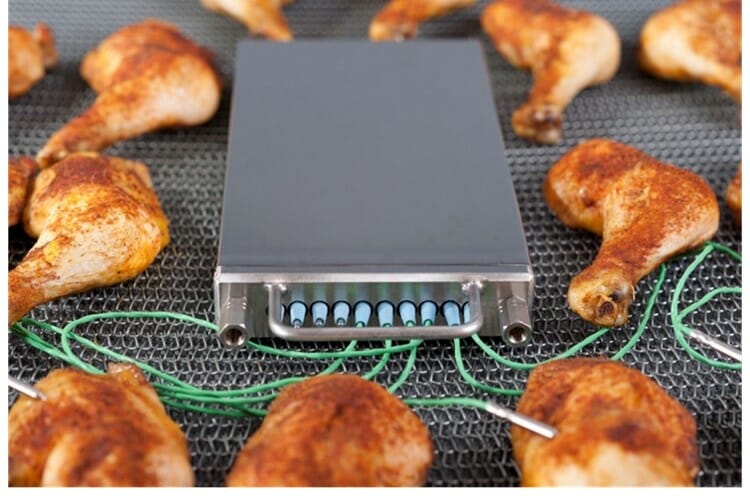
With in-process loggers, the temperature-checking device runs in the same process space as the one using it. In-process loggers are ideal for production lines that pass through the cooking unit, as illustrated below.
The entire (heatproof) unit passes inside the cooking unit, from ovens to fryers, typically on the same conveyor belt that carries the food items.
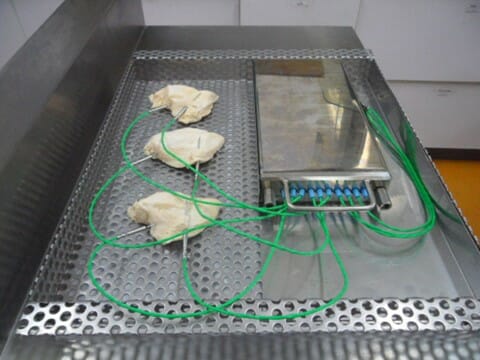
2. Out of Process
An out-of-process logger essentially means that the component runs in a different process space than the one using it. These types of loggers are not heat-resistant, so you have to place the component outside the cooking unit with the probes extended inwards.
If set up correctly, out-of-process loggers usually provide sufficient temperature logging data but need more completeness and convenience of the in-process loggers.

3. Spot Check
Spot check thermometers are handheld, accurate devices used to verify the temperature of cooked food along the production line. Most food manufacturers carry out these checks regularly, assigning an employee (often one of the Quality Assurance team) to conduct probe checks on production lines at a set interval, such as every 15 or 30 minutes.
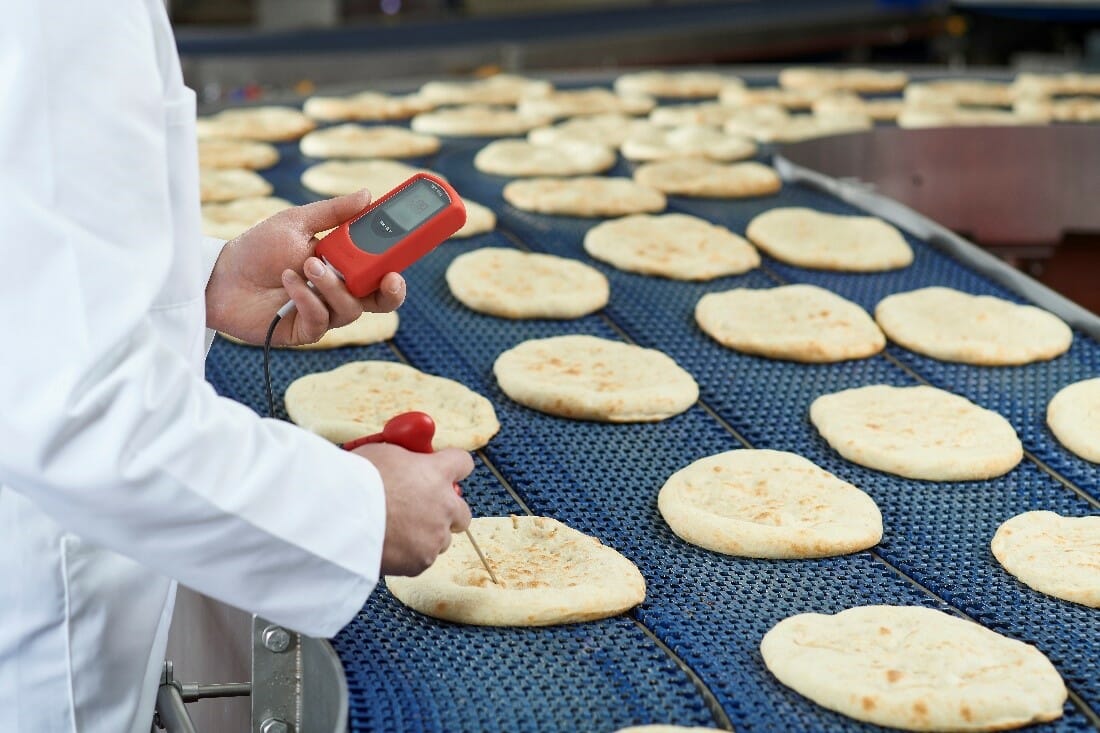
4. Finished Product Checks
Finished product checks are carried out after the food item is packaged and ready for dispatch. Usually, these are ‘destructive’ tests, whereby the tester uses the probe to pierce the item’s packaging and verify its temperature. The food is then discarded. The recent BRCGS Food Safety Standard Issue 9 outlines this in more detail (see Clause 6.1.5).
Infrared thermometers are a sufficiently accurate (and sometimes speedier) method for finished product checks, returning quick results which can be further verified with a core temperature check using a probe if required.

5. Storage Checks
These are somewhat self-explanatory – verifying the temperature of items kept in storage. One of the most accurate, time-efficient ways to observe this is with a wireless monitoring system. These systems offer real-time temperature monitoring, automated reporting for easy analysis, and instant alarm notification to circumvent stock wastage.
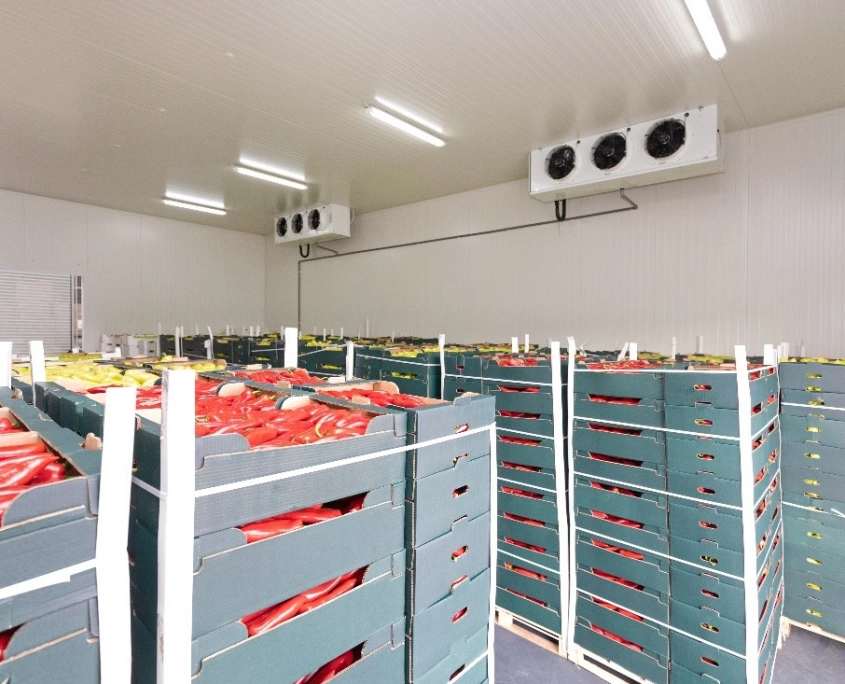
Having evaluated the role of loggers, it is next relevant to examine the second, often overlooked part of temperature control: equipment calibration.
Take fridge temperature monitoring as an example. Given that most fridges and chillers have a temperature display, it’s fair to question why a secondary temperature check is necessary.
The answer is that temperature displays typically show the temperature a fridge is set to rather than the temperature it is reading – hence the near-impossibility of verifying its true accuracy. Malfunctions or breakdowns are common issues with any refrigeration or cooling unit. Therefore, it is important to regularly carry out independent temperature checks to ensure that the fridge temperature is safe – especially if the products are high-risk and/or perishable.
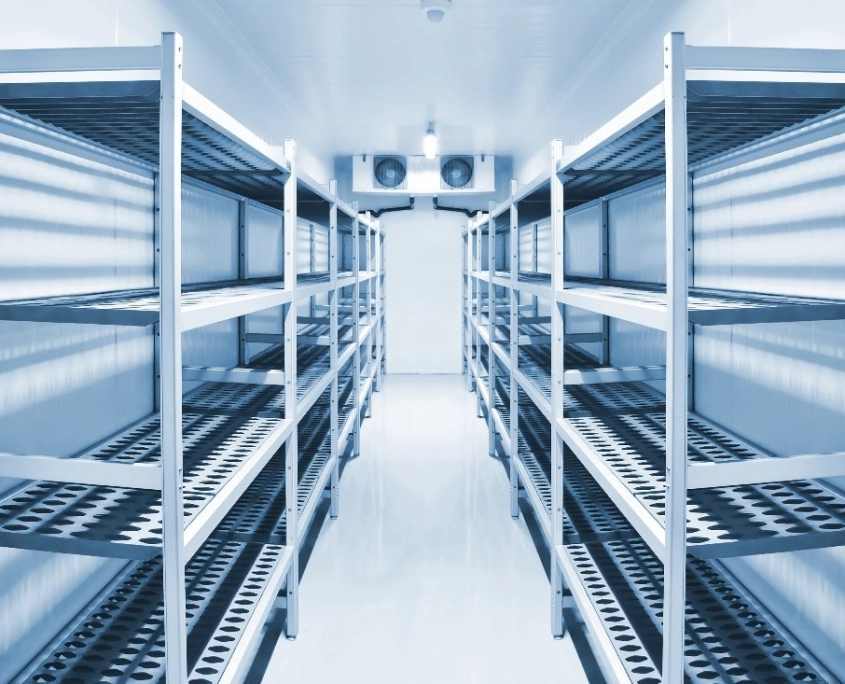
The BRCGS’ Global Standard for Food Safety is reinforced by the Food Standards Agency’s advice on chilling, which states:
“Using a thermometer, you need to check that your fridge is cold enough. This is because the dials on fridges sometimes show you the wrong temperature, and your fridge should be 5°C or below.”
In addition to food safety and quality, fridge monitoring systems with alarms offer excellent risk management and cost-savings – particularly for larger chillers which may contain hundreds or thousands of pounds’ worth in storage. Non-compliances that result in loss or wastage can be identified and prevented before the stock has to be unnecessarily discarded.
A precise guide to temperature control food safety
Have you ever heard of FU and PU values?
These are two crucially important principles for determining the point at which food becomes ‘cooked’ and safe to eat. When utilised correctly, FU and PU values establish the lethality of a thermal process.
More information on how to calculate the values can be found here. Correct calculations will allow you to find the sweet spot between time and temperature – although some stellar systems include software that automatically calculates these values.
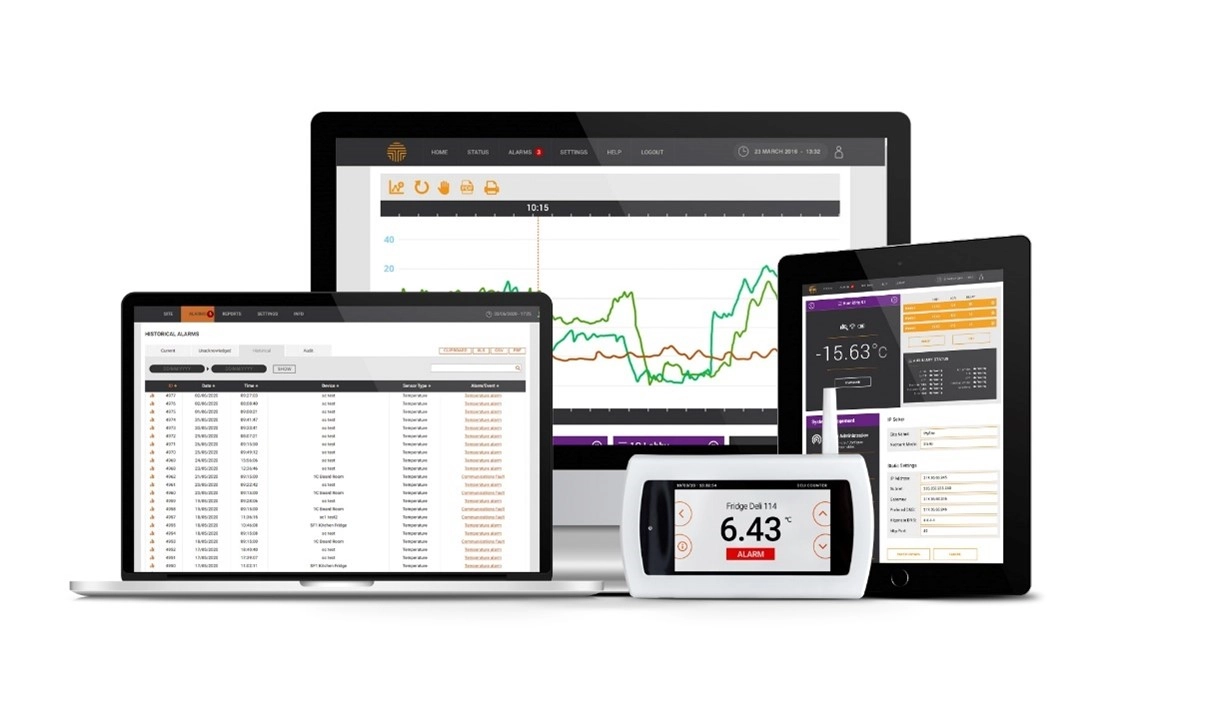
In technical circles, cooking is typically defined as a thermal process designed to reduce Listeria monocytogenes at the equivalent of 70°C for two minutes.
Taken from BRCGS Food Safety Standard Issue 9 (pp. 146–147), the below table demonstrates the equivalent cooking processes designed to achieve 70°C, calculated using a z value of 7.5°C. For example, if the food is heated at 68°C, the table indicates that one minute of cooking is the equivalent of 0.541 minutes at 70°C. Therefore, to achieve the equivalent of two minutes at 70°C, it would be necessary to heat the food at 68°C for 3.70 minutes (2 ÷ 0.541 = 3.70).
| The temperature at the slowest heating point | Lethal rate (equivalent to 1 minute at 70°C) | Time required at the referenced temperature to achieve an equivalent process (min) |
| 60 | 0.046 | 43.48 |
| 61 | 0.063 | 31.74 |
| 62 | 0.086 | 23.26 |
| 63 | 0.116 | 17.24 |
| 64 | 0.158 | 12.66 |
| 65 | 0.215 | 9.30 |
| 66 | 0.293 | 6.83 |
| 67 | 0.398 | 5.02 |
| 68 | 0.541 | 3.70 |
| 69 | 0.735 | 2.72 |
| 70 | 1.00 | 2.00 |
| 71 | 1.36 | 1.47 |
| 72 | 1.85 | 1.08 |
| 73 | 2.51 | 0.80 (48s) |
| 74 | 3.41 | 0.60 (36s) |
| 75 | 4.64 | 0.43 (26s) |
| 76 | 6.31 | 0.32 (19s) |
| 77 | 8.58 | 0.23 (14s) |
| 78 | 11.66 | 0.17(10s) |
| 79 | 15.85 | 0.13(8s) |
| 80 | 21.54 | 0.09 (5s) |
Essential to lethality is the aforementioned ‘Danger Zone’, the specifications of which are illustrated in the below table. Refer to this for a breakdown of the specific temperature control ranges.
| Food Zone | Temperature Range | Description |
| Hot Food Zone | 60°C+ (140°F) | Food must not drop 60°C below when being displayed or served (we recommend cooking it to 74°C+) |
| Danger Zone | 4°C to 60°C (40°F to 140°F) | Bacteria grow most rapidly, doubling in number in as little as 20 minutes. After spending two hours in the Danger Zone, high-risk food must be thrown away. |
| Cold Food Zone | 0°C to 4°C (32°F to 40°F) | This is the normal temperature range for most refrigerators. |
| Frozen Food Zone | -18°C or lower (0°F) | Most freezers are set to -18°C or below |
What is the difference between verifying internal and external food temperatures?
An infrared thermometer takes the temperature of the outside surface of the food. It does not display the internal temperature of the item and, consequently is better suited for checking the temperature of cold foods where only the surface temperature is required.
A probe thermometer is usually the preferred method to check the temperature of cooked food. Some teams may decide that an infrared thermometer is sufficient, although due to the much wider accuracy range of an infrared thermometer (e.g. +/- 2.5°C as opposed to +/- 0.5°C on a probe thermometer), they would have to be aiming for a higher temperature reading in order to ensure compliance and food safety.
When cooking, the outside of the food is always much hotter than the core. To ensure the food is cooked through, it is vital to check the core cooking temperature with a temperature probe.
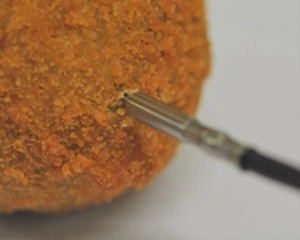
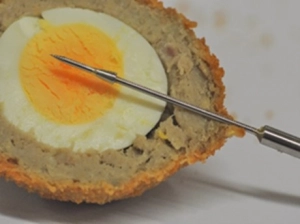
Click here for a useful chart outlining the safe minimum internal temperature for cooking various food items, taken from Food Safety Gov UK.
What are the requirements for food receiving temperature?
If you’re a food business, it’s important to only accept delivery of food you are sure is safe and suitable. Generally, this means the food is delivered from a known supplier, protected from contamination, and handed over at a safe temperature.
It is also worth formally agreeing with your delivery business at what temperature the food will be delivered at or a safe time period. Once you’ve received your food and everything is acceptable, it is crucial that you keep food under temperature control.
Ways of reducing the risk of receiving non-compliant food include:
- ensure you can identify all delivered food and you know the supplier’s name and address
- ask your supplier to protect food from contamination (e.g. in food-safe packaging)
- ensure someone is on-site to inspect food as it is delivered
- check delivered food is properly covered or packaged
- check that there are no mold, insects, droppings, or foreign objects (like glass or metal) in the food
- check that the use-by date of items has not been passed
- if the food is potentially hazardous, check that it is delivered at the correct temperature
- check that frozen food is delivered frozen hard
- check that chilled food is delivered at 5°C or colder
- check that hot food is delivered at 60°C or hotter
- if you have agreed to accept food between 5°C and 60°C, check that the delivery has not taken longer than the agreed time (check departure and arrival times)
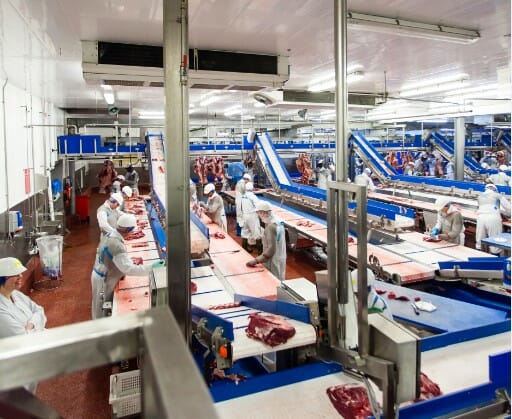
This article has focused on temperature control within the cooking process. Controlling the temperature of production areas, ingredients, and products during storage and transport (both before and after manufacturing and cooking) is also vital to ensure audit compliance and food safety. Alternatively, if you want to learn more about food temperature, read this article on temperature mapping.
Safefood 360° is an innovative software designed by food safety experts, and we are dedicated to providing solutions for a safer world for food manufacturers. Subscribe to our newsletter for the latest food safety news. If you would like more details about how to ensure the food safety of your company, submit a demo request here.
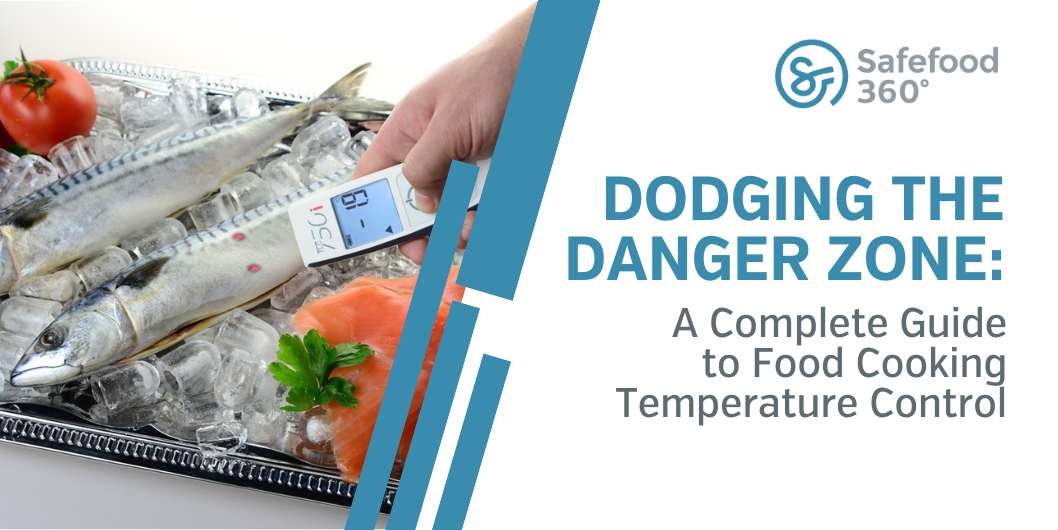
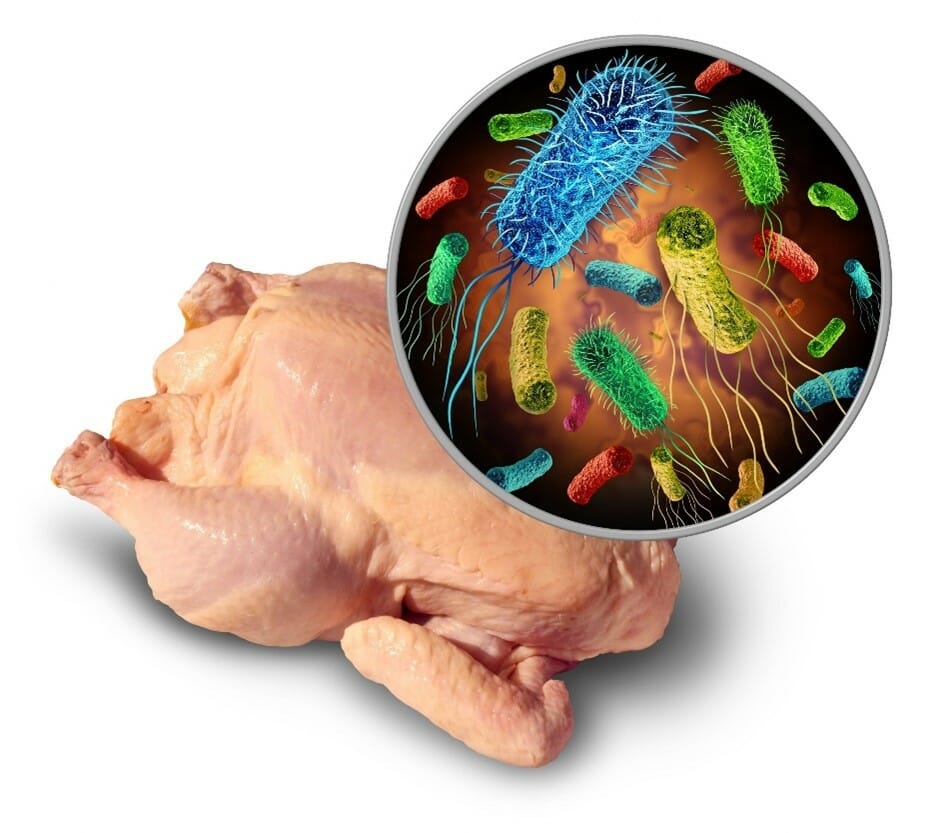



Leave a Reply
Want to join the discussion?Feel free to contribute!